A Literary Embarrassment
April 02nd, 2007
What do we do with the embarrassments in our literary history?
The three novels by American-born Alex Philip (1882?-1968) are a case in point. He and his wife, Myrtle Tapley Philip (1891-1986), are now mythologized as the “fearless pioneers” whose opening of Rainbow Lodge at Alta Lake in 1915, following the arrival of the PGE railway in 1914, initiated tourism in the Whistler Valley. The site of Rainbow Park preserves some of the resort’s early cabins and photographs, and a local elementary school is named after Myrtle, to honour her long record of community involvement.
Alongside the hard work of enlarging and managing the resort, which offered fishing in summer, skating in winter, and by 1948 had reputedly become the most popular honeymoon destination west of Jasper, the ever entrepreneurial Alex found sufficient time and energy to pen three novels which exemplify the clichés of Western romance, transported to the coastal and interior landscape of BC: The Crimson West (Toronto: Thomas Allen, 1925), The Painted Cliff (Ottawa: Graphic, 1927), and Whispering Leaves (Ottawa: Graphic, 1931). Philip’s first title became the basis of Canada’s first talking film, The Crimson Paradise, made in Victoria in 1933, and now declared lost.
My curiosity about Philip’s books turned to dismay when I actually read them. In his efforts to exploit the BC landscape to create popular adventure fiction, Philip employed nearly every offensive stereotype of his age.
The plot of The Crimson West is furthered by nasty labour organizers, unpleasant immigrants from eastern Europe, and deceptive Natives. The villain of The Painted Cliff is a “crazed chieftan” with a gorgeous granddaughter who also loses her reason when deserted by her white lover. Whispering Leaves includes Mexicans and “Chinamen” who smuggle drugs and Asian labourers into the Cariboo. Of course most of the women are amorous wimps in need of rescue.
Reviews preserved in the Myrtle Philip fonds in the Whistler Museum and Archives indicate that the books were generally well received, notwithstanding a few cavils about their amateurishness and stretching of credibility. The reviewer for the Montreal Star described The Painted Cliff as “a really excellent yarn” by “a veritable Rider Haggard of the Pacific Coast,” and commented that “the mountains of British Columbia can be made into as good a backdrop for the bizarre as anything in South Africa.”
It might be fun to examine the ways that Philip romanced the West by importing popular adventure conventions into a BC landscape full of local details about railroads, logging, prospecting, and agriculture, and to analyze his construction of Anglo-Canadian-American masculinity (the rugged hero wins all the fist fights). His gratuitous racism and sexism could be studied as representative of the common mindset of the 1920s. But – who needs to know about him?
These books are clearly not candidates for resurrection for the general reader. And I don’t think that undergraduates would get much out of them. If the racism of the 1920s is on the curriculum, students can read Hilda Glynn-Ward’s notorious novel, The Writing on the Wall (1921), which was turned into an historical document when it was reissued in 1974, with an introduction by Patricia Roy, in the social history of Canada series edited by Michael Bliss for the University of Toronto Press.
What initially seemed to be an interesting discovery in relation to the literary history of BC – and a potential contribution to an historic identity for Whistler that is unrelated to the current Olympic frenzy – is now destined to gather dust in a remote corner of my bookshelf. I went out of my way to acquire copies of all three books, as two were published by Graphic, a small Ottawa press (1924-32) that is now memorable for its efforts to create attractively designed books that were “100 p.c. Canadian.”
My copy of Whispering Leaves wears its original dust jacket, whose elegant unsigned front and spine illustrations – featuring vegetation that looks surprisingly tropical – are considerably more appealing than its contents. I may show the volume to students as an example of a nicely made book, but I’ll probably stop short of recommending that they actually read it.
[According to Wikipedia, Canada’s first “talkie,” The Crimson Paradise, made in Victoria in 1933 and based on Alex Philip’s first novel, was very popular when it ran at the Victoria’s Capitol theatre, partly due to strong promotional efforts by the Bristol-born theatre manager Ivan Ackery who persuaded Famous Players to allow him to screen the made-on-Vancouver Island feature. The film was produced by Kenneth Bishop’s Commonwealth Productions. – Ed.]
Essay Date: 2007

